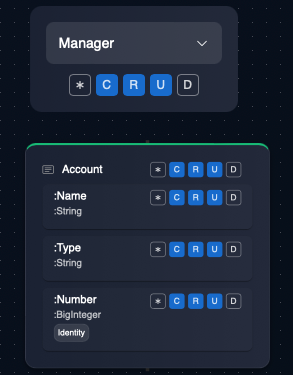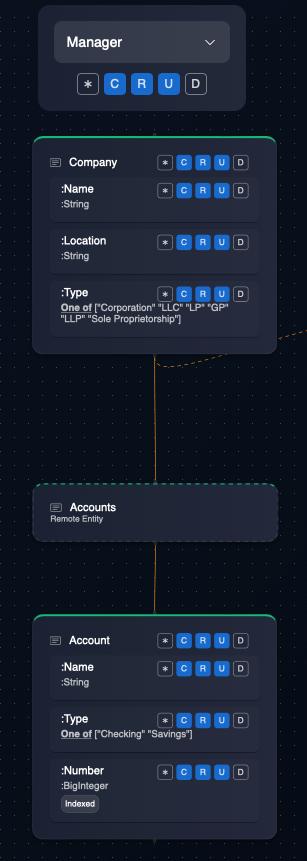Zero-trust Programming
By default, a Fractl application in production will not allow any operation - read or write - on entities and relationships without permits. The developer has to explicitly permit operations on each construct - this enables fine-granular security right in the programming language. Further, Fractl incorporates facilities to add/modify/revoke permissions during runtime, enabling the application security rules to be dynamically modified based on changing needs.
Note: An "entity" is different from an "instance of an entity" - the former is a type, whereas the latter is a value of that type.
Fine-granular Access Control
The following are some of the salient security features in Fractl:
- Role-based Entity Permissions: Developers can define permissions for users of different roles to perform CRUD operations of entities declaratively.

In the example above, any user of the role "Manager" can perform Create, Read and Update operations, but not Delete operation on the entity and its attributes
- Instance Ownership-based Permissions: An instance of an entity created by a user is "owned" by the user. The owner can perform any operation on that entity instance. Role-based Entity Permissions are too permissive for most use cases and should be used cautiously. A good pattern is to only allow Create permissions for a role and disable other permissions. With this, users associated with the role can only create new instances of the entity and not be able to read/update/modify any other instances. The created entity instances will now be owned by the user and this ownership allows the user to perform all CRUD operations on that particular instance of the entity (but not on other instances of the same entity).

- Permissions flow: The Graph-based Hierarchical Data Model introduced by Fractl enables a zero-trust programming paradigm with minimal configuration. Permissions flow down the data model tree via the
:containsrelationship links. This permission flow applies both to Role-based permissions and instance ownership-based permissions:- RBAC: In the example below, any user that belongs to the
managerrole can perform Create, Read, Update operations on entity "Company". As a result, the user can also perform the same exact set of operations on "Account" under "Company". (Also see the documentation on RBAC). - Instance ownership: A user who "owns" an instance of the entity "Company" automatically owns all instances of "Account" under "Company".
- RBAC: In the example below, any user that belongs to the
